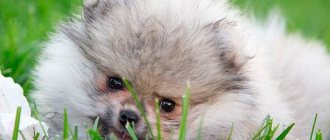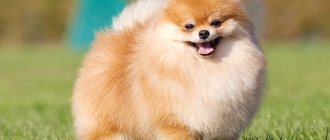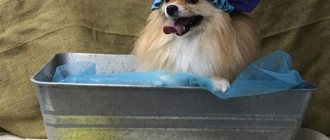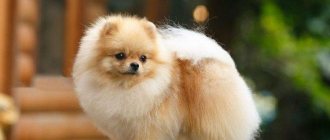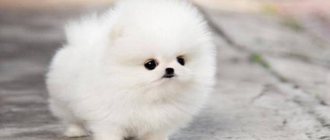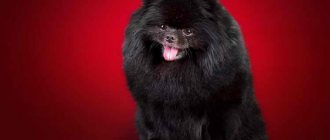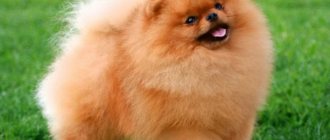German Spitz are charming dogs, ideal for people who love active recreation and attention from their pet. The breed was formed in Germany in the Middle Ages, when Spitz dogs were human assistants in protecting herds of domestic animals.
The size of the dogs did not matter; small representatives of the breed were not specifically crossed. Thanks to this, the color of the Spitz still has variety, which is assigned in the breed standard .
Dogs can be silver, chocolate, beige and, of course, red. In the 18th century, the rest of Europe became interested in the breed, and puppies began to be bred as indoor decorative dogs, which received the international name - Pomeranian Spitz. The size of such a dog does not exceed 22 cm, and the weight should be proportional to its height.
Today, the standard provides for 5 types of Spitz, varying in height at the withers and color. The Pomeranian, otherwise called the dwarf, is also included in the standard; its color can be red, cream, zoned, spotted black or spotted.
Thoughtful selection led to the emergence of subtypes among oranges. These are dogs of the so-called fox and bear types.
The fashion for the breed does not change, and Spitz dogs are very popular dogs, especially for urban residents, but the choice of the popular shape of the face and ears of the future pet involves varying prices for these types.
Important! Remember that only a fox-like muzzle and triangular ears are considered standard for miniature Spitz dogs - you can participate in exhibitions with such a dog. A bear puppy will not be allowed to participate in competitions.
The Little Fox Spitz and the Bear Spitz are the same breed, the only difference being the shape of the head and ears. It is important to note that the appearance of a puppy of one or another subtype is determined by genetics.
Parents who have all the classic traits of the breed can produce puppies of both the bear and fox type . This means that one of the dogs of previous generations had round ears and a short muzzle.
Breeding exclusively the bear type is impossible, and even if such dogs are obtained with a very short muzzle, more reminiscent of the flattened profile of a Pekingese, then they are not distinguished by good health. Respiratory diseases shorten the lifespan of these dogs, so such breeding is not encouraged by kennels that care about the quality of the breed standard.
Description
Dwarf Fox-type Spitzes most closely match the described breed standard, but, surprisingly, they cost less than the bear or toy type. Buyers are more attracted not by the standard, but by the charming appearance of the dogs. Chanterelles are distinguished from classic Spitz dogs by their elegance and grace; they really look like miniature foxes. Their weight ranges from 1.7 to 3 kg, height – from 16 to 22 cm.
Dogs live for about 15 years. But there are cases when, with good care, animals live up to 19–20 years of age. If a Fox-type Spitz meets the standard, it must look a certain way.
- Despite its elegance, the Spitz's physique is muscular and square: the length of the body and the height at the withers are the same in size. The back is level, ending in a wide croup.
- The head is wedge-shaped with an elongated fox-like muzzle. Pomeranian Spitz puppies are not immediately recognizable as a species, but it is the fox type that begins to appear earlier than others and becomes noticeable by the stretching of their muzzle.
- The Fox Spitz has a narrow lower jaw, and the upper jaw is larger than the lower jaw. Type of bite: scissor bite.
- Triangular, protruding ears located close to each other.
- Almond-shaped elongated eyes of a dark color.
- Long graceful paws.
- The tail is curled into a fluffy ring.
- Long coat with thick undercoat. The guard hair is straight, does not lie along the body, but sticks out perpendicular to it. Wavy coat is not standard. The fox's fur coat is decorated with a fluffy collar on its neck and pants on its hind legs.
- 12 colors are allowed for the exhibition. Among the chanterelles, the most common ones are red, sable, beige, and cream. White spots and tan marks are considered defects.
How are breed standards determined?
The standards for the little Spitz fox are set by the American Kennel Club. The dogs have the following differences:
- characteristic muzzle, like that of a small fox: fluffy cheeks, tiny narrow nose and jaw;
- coat of different shades of red, medium density, fluffy and silky, long in the chest area;
- almond-shaped eyes;
- triangular, close-set ears;
- thin, tall limbs with long fingers;
- fluffy tail like a donut.
Pomeranian fox-type puppies cannot be immediately identified in the litter, but as they grow older, their nose becomes elongated.
The birth of babies from fox parents does not guarantee that they will meet the characteristics of the breed.
Lifespan
The bear-type Pomeranian has good health and, with proper care, can live up to 12-15 years.
Representatives of this breed are characterized by the following diseases:
- cardiovascular pathologies;
- abnormalities in the functioning of the respiratory organs;
- problems with the visual and auditory systems;
- disruption of the musculoskeletal system;
- damage to the central nervous system;
- dental diseases;
- changes in the functioning of the gastrointestinal tract.
In addition, females often experience complications during childbirth.
To prevent infection of a miniature Spitz with various infections, vaccination is carried out according to the following scheme:
- At 8 weeks, a vaccine against plague, hepatitis, enteritis, parainfluenza and coronavirus is administered. Followed by booster vaccination at 12 weeks;
- at 6 months - rabies vaccination.
After the dog is 12 months old, it is vaccinated once a year. A corresponding note is made in the veterinary passport.
Note! Before vaccination, you should make sure that the dog is healthy. A week before vaccination it is necessary to carry out deworming
Mating
Acceptable age for first mating is 15 months. (for males – 1 year) . However, dogs reach full maturity at 24-30 months. , and it is better to postpone the meeting with your partner until this date. Parents are selected taking into account the possibility of improving the breed characteristics of both representatives.
The color of future puppies can be predicted by studying the basics of genetics. Both males and females must be dewormed, have vaccinations, and have show records to prove they are appropriate for the breed.
The first mating is complemented by a second, sometimes a third, with a break of 24 hours . The meeting is held on the territory of the male; the couple can be introduced on neutral territory.
Read a detailed article on the topic: “Everything you need to know about breeding dogs: appropriate age, what to do if it doesn’t work out, rules and tips.”
Advantages and disadvantages
Pros:
- Beautiful and graceful.
- Sweet, playful, friendly.
- They get along well with other pets.
- They treat children well.
- They can take root even in a small apartment.
- A Spitz can be trained to use a litter tray or diaper.
- They are hardy and have good health.
- Not too picky about feeding.
- Such a dog will become a good guard for an apartment.
- The small size of the pet allows owners to take it with them everywhere.
Minuses:
- Sometimes they are overly cocky towards other dogs.
- They are noisy: if you don’t stop them from barking, they will do it all the time.
- They are characterized by increased emotionality.
- Shedding in fox-type oranges can be very pronounced and lasts quite a long time.
One of the advantages of fox-type dogs is the relatively low cost of puppies compared to other Pomeranians.
Dog character and behavioral characteristics
Pomeranian and German Spitz: differences
Dogs of this breed are always friendly and devoted creatures. The pet treats its owner and his family members with trepidation. Gets along with children and enjoys playing outdoor games with them.
Note! The dog is quite active, especially in puppyhood. The animal needs to run, jump, chase a stick. A long time spent doing nothing can lead them to despondency and sadness.
The Spitz fox, in addition to the indicated data, also has hunting instincts. They have a well-developed sense of smell and hearing. In addition, dogs are quite attentive and do not miss a single detail.
Despite its small size, the pet is capable of performing the function of a guard. A Spitz can rush to protect its owner or his home without fear.
What are the differences between the breeds?
Height and weight
| Indicators | Pomeranian Spitz | German Spitz |
| Weight | 2-4.5 kg. | Small (Kleinspitz) - 8-10 kg, medium (middlespitz) - 11 kg, large (grossspitz) - 13 kg, Wolfspitz - 20-28 kg. |
| Height at withers | 18-22 cm. | Small (Kleinspitz) - 22-28 cm, medium (Middlespitz) - 29-39 cm, large (Grossspitz) - 40-50 cm, Wolfspitz - 42-56 cm. |
NOTE! Only the German Spitz is registered with the Fédération Cynologique Internationale (FCI), while the Pomeranian is no more than one of its varieties. The Pomeranian is recognized as a separate breed by clubs in Canada, England and America (American Kennel Club)
Body type
| Indicators | Pomeranian Spitz | German Spitz |
| Head | In the shape of a cylinder. The forehead is convex, the transition to the muzzle is well defined. The length of the muzzle is slightly shorter than the skull. The general appearance of the head resembles that of a bear. | Wedge shaped. The transition from forehead to muzzle is smooth. |
| Ears | Widely spaced. Small ones. | Closely spaced. With sharp ends. |
| Teeth | Incomplete teeth are acceptable. | Full composition (42). |
| Eyes | Not convex, oval in shape. Dark color. | Small, oval shaped. Dark color. |
| Neck | Short, wider at the shoulders. The fur falls off in the form of a mane. | Set on high. |
| Torso | Square format. | Square format. |
| Paws | Strong, with undercoat. | Small, thin, without undercoat. |
| Tail | Arc-shaped. | Has the habit of twisting into 1-2 rings. |
Simply put, if a dog looks like a little bear cub moving its well-fed legs, then it is an Pomeranian. They, as a rule, have a round muzzle and are slightly pressed down, while the German muzzle is elongated, like a fox. Among other things, the dog is distinguished by a lush mane and sophisticated paws.
Wool texture
The German has two types of hair: the outer coat (long, coarse, straight hair) and the undercoat (short, wavy hair). The animal's coat often puffs up in different directions, which is why the dog looks like a soft toy.
The coat color of the German Spitz is quite varied, but primarily depends on the variety.
The Pomeranian's undercoat is long and the hair tends to resemble a spiral. On the head, this is especially noticeable when the hair folds into the shape of a cap on top, and below it falls in the form of a mane. Pomeranians have weakly expressed guard hairs and the pet's feel can be easily compared to cotton wool.
Acceptable colors:
- black;
- black and tan;
- white;
- cream;
- sable;
- chocolate;
- zonal gray;
- orange.
Character
The Pomeranian has an active lifestyle and a desire to be anywhere and everywhere. These pets are not familiar with the blues; dogs will always find something to do with themselves. In short, Spitz dogs can be characterized as follows: plays, eats, plays, sleeps. And again.
The German is calmer and more balanced. He, of course, will not ignore the game, but if the owner is busy, then the German Spitz will not annoy him and will patiently wait.
Unlike the Pomeranian, who is driven by energy, the German is driven by alertness. These dogs still play the role of a companion for their owners, and therefore it is natural for them to play the role of protector and support for the family.
How to perform the procedure yourself
Haircut like a fox is quite complicated in technique, but if you follow certain rules and watch training videos, you can do it yourself:
- Carefully trim the fur around the root of the tail, making it look like a fox.
- Remove excess hair from the dog's ears, collar area and paws. Carefully remove any lint from between your fingers.
- Align the fur along its entire length so that individual hairs do not stand out from the overall picture.
You can trim your Spitz with scissors or a professional clipper. To carry out the procedure yourself, prepare single-sided thinning scissors and scissors with blunt ends. You also need a massage brush and a comb with metal teeth.
Grooming should be done regularly to keep your pet looking neat.
Chanterelle
Important ! Never cut your dog's head, otherwise the hair may not grow back.
Distinctive features
There are three types of Pomeranians:
- Standard, with a fox-like, elongated muzzle.
- Baby doll, with a wide muzzle and a higher slope than the previous type.
- Teddy bear, with a significantly shortened and flattened muzzle.
The main difference between them is the shape of the head. The rest of the exterior parameters, including weight and height, are similar to each other.
Distinctive features of the bear-type orange:
- The head is round, medium in size, wedge-shaped, tapering towards the nose.
- The ears are erect, small, set high and close to each other.
- The stop is noticeably pronounced, the transition line is smooth.
- The muzzle is clearly flattened and wide.
- The eyes are located close to each other, round, small.
- The cheekbones are rounded, do not protrude, and are covered with hair.
- The chin is raised.
- Nose up; the lobe is round, usually black (in Spitz browns, it matches the color of the coat).
- The lips fit tightly and do not sag; black color.
- The jaws are clearly defined.
- There are 42 teeth in a complete set.
- The bite is usually scissor-shaped; but straight is allowed, which is not a defect of the breed.
- The neck is set wide, completely covered with thick hair, and looks like a collar.
- The chest is deep and well defined.
- The loin is short and strong relative to the body.
- The stomach is tucked, the line is smooth.
- Limbs straight, parallel; the thighs are covered with very thick hair.
- The paws are small, round, “cat-like” (collected in a ball, have an arched shape); The pads are powerful, covered with thick skin, and leave a round mark.
- The tail has thick hair, reaches the middle of the body, and is set high; there is a double curl at the tip.
- Movements are free, straight, elastic.
- The coat is long, over 5-6 cm, straight; There is a dense but soft undercoat.
Small German Spitz
The Small German or Kleinspitz is one of the varieties of its group . His height should be 23-29 cm , weight is not strictly estimated, usually it is 3-6 kg . The dog's appearance fully meets all the requirements for Spitz dogs. The difference is in the ratio of the length of the muzzle to the size of the skull ( 2:4 ) and the number of teeth (the absence of some premolars is acceptable).
Acceptable colors for the variety: white, orange, black, brown, wolf. The latter is also called “gray with black”. It consists of silver hair with black tips, a dark zone on the face and ears, a light zone on the mane, shoulders, edge of the tail and pants. Also characteristic is a dark rim around the eyes.
Pure cream and white colors, sable with red or cream tint, black and tan and spotted are also acceptable. In the latter case, on a white background there are spots of a different tone, evenly distributed throughout the body.
German Spitz are pets with a funny appearance and balanced character. With proper upbringing, they become ideal friends for the whole family, but you should not treat them like a toy and spoil them too much.
5 / 5 ( 3 voices)
Advantages and disadvantages
Pros:
- Beautiful and cute appearance.
- Suitable for keeping in a city apartment.
- Cheerful, energetic and lively.
- Loyal and affectionate towards their owners.
- Most mini Pomeranians are in good health.
- You can choose a pet of any of three types: “fox”, “bear” or “toy”.
- If you wish, you can trim your pet to your liking.
Minuses:
Can be cocky towards other dogs. Their fur needs to be properly cared for. Dogs with short muzzles may suffer from respiratory or cardiovascular diseases. If raised incorrectly, they become stubborn, aggressive and capricious. Not suitable as a gift for children. They require careful and careful handling, as they are particularly small in size and at the same time very mobile. They shed heavily. Bitches often have difficult births.
Mini Pomeranians are more demanding when it comes to feeding than standard dogs of this breed.
Education and training
This breed is incredibly intelligent and can learn new commands with ease. However, the education process must be approached responsibly. Incorrect human behavior often leads to the animal becoming aggressive and angry.
Kangal (dog): Turkish wolfhound, comparison with Alabai
The first thing you should teach your furry friend is obedience and following the simplest commands. You can start studying from 1-1.5 months. In the first stages, a person will have to be patient and constantly repeat the same commands.
Some tips regarding the educational process:
- workouts are performed regularly for the same time. It is not allowed to take breaks;
- Before a new lesson, you must go through the material already covered;
- Praise and punishment should be alternated evenly;
- You cannot be violent towards an animal.
Important! An adult dog is much more difficult to train. It is necessary to start training as early as possible.
Fox type Pomeranian
The Pomeranian fox is considered a dog that almost perfectly matches the classic type of the breed. He looks like an ordinary German Spitz, except that he has a denser and more printed coat.
The characteristic external features of these dogs are a wedge-shaped muzzle, expressive dark almond-shaped or slightly rounded eyes, a small black nose and a sharp chin.
The fur of the “fox cubs” is of medium length, but the tail and paws are slightly longer than those of the “bear” and “toy” Pomeranian types.
Unlike “bear cubs” with their rounded heads and short, wide muzzles, as well as “toy cubs”, which are an intermediate type, “fox cubs” have a narrower and wedge-shaped head and muzzle.
What is the difference between a Spitz bear and a fox
Another popular subspecies of the breed is the bear. The most reliable way to distinguish a “bear” from a “fox” is to compare their ears. For the former, they fully comply with the standard, that is, they have a triangular shape. But the second ones have rounded ones. Moreover, the difference appears quite early - at about 3-4 months. Therefore, the risk of error is quite small. And in adults it is even more noticeable. In addition, the latter really look like bear cubs - they are not so tall, more squat.
The bear cub is immediately visible
Breeding
The Pomeranian Spitz is a rather difficult breed to breed. If the classic small Spitz has existed for hundreds of years, has good health and is quite stable in breeding, then a new type called POMERANIAN is a “hybrid” artificially created by geneticists from a German Spitz with an admixture of Pekingese and Chow Chow. In order to obtain a more “marketable” appearance, breeders bred the same Poma that breeders strive for.
Moreover, the constant crossing of typical representatives of the “inter-vegetable” type to consolidate it in the descendants, in combination with the youth of the experiment, often leads to an unforeseen result. Trying to get a more fluffy, short-faced and small Spitz, nurseries, in addition to these advantages, acquire black skin disease, problems with the heart and dental system. Such small dogs, which they try with all their might to turn into sofa toys, simply do not grow teeth because they are unnecessary.
Despite all the difficulties of breeding, the main problem of the breed and the high cost of puppies is its low fertility. While small German Spitz dogs are capable of giving birth to 4-5 puppies on their own, Pomeranians have difficulty giving birth to 1-2 puppies. And even they don’t always turn out successful. That is, marriages often occur in such small litters. From malocclusion to white spots on colored dogs. Often dogs brought from America have rare colors in their pedigree that are not recognized in the RKF. As a result, the breeder may receive defective offspring from an imported bitch purchased for several hundred thousand.
Due to the many losses and unjustified expectations of breeders, endless questions about beautiful puppies at a cheaper price sometimes force us to react rather rudely. Because they know first-hand by what means this result is achieved. Especially if the buyer says that he wants an inexpensive white Pomeranian for exhibitions. Such a nugget is extremely difficult to obtain, and if someone succeeds, then not a single professional will part with it.
Tendency to diseases
Spitz are dogs with good health. They are distinguished by their longevity. With good care they live up to 20 years. But even they can be plagued by diseases that you need to know about:
- diseases of the musculoskeletal system (necrosis of the femoral head, subluxation of joints, dislocation of the patella);
- complications during labor;
- bulging eyes characteristic of dwarf breeds;
- eye diseases (including cataracts, entropion, retinal dysplasia and atrophy);
- complications with teeth (especially during their change).
- inguinal and umbilical hernias;
- heart diseases;
- breathing problems, frequent coughing and sneezing.
How many months does a Spitz grow?
Let's look at the main stages of a dog's growth and find out at what age a Spitz stops growing.
One of the parameters by which you can determine whether a dog is healthy is height. Therefore, it is important to know at what stage of life what height a pet should be, and to what age Spitz grow.
Little dog
The Spitz is fully formed at two to three years old, the development of bones and organs ends, and the puppy turns into an adult dog.
Types of white Spitz
The white Spitz attracts the attention of many. After all, snow-white shiny wool looks rich
Such dogs were bred in several countries, and the following representatives of the breed with white hair are known in the world:
- Japanese Spitz. Came to Japan from Siberia and China, where it has been bred since the 20s of the last century. At the withers, the height reaches 40 cm; the color of the coat does not change with age. Has a black nose, dark eyes, black lip contour. The dog is distinguished as clean. Like all representatives of the breed, he needs to be brushed frequently (every day or 3 times a week).
- American Eskimo Spitz. It has a history similar to Japanese. White dogs came to America in the 20th century, where they became popular, and by 1970 a standard had been formed. This type has three varieties in height - from toy (23 - 30 cm) to large (38 - 42 cm). Playful and hyperactive, like all his brothers of other colors.
- Large German Spitz. An ordinary red or black dog by crossing white dogs has obtained a snow-white coat, which can fade into cream or reddish-beige. The pet's height reaches 50 cm. The standard corresponds to an animal with dark eyes and a black nose, without spots. The coat is thick and long.
- Volpino Italiano. In the 17th century, it began to be bred in Italy as a decorative dog for rich ladies. Reaches a height of 30 cm at the withers. There are black and red Volpino, but rarely, since white is considered the standard, and kennels breed dogs of this color.
- Small German Spitz and Pomeranian Spitz are sometimes born white and do not change color, but this is a rare case, and such puppies need to be “hunted” if you are determined to have a snow-white dog.
Large (wolf)
The name Keeshond is also used. The largest type of the German ones. They are distinguished by a strong build. Males are 42 - 47 cm tall and weigh about 20 kilograms, females are 40 - 45 cm and weigh 16 kilograms. The color is very similar to a wolf, zonal gray with a black mask on the muzzle. The ears and tip of the tail should also be black. They are used as herding dogs and guard dogs . Aggressive and distrustful of strangers. The average lifespan is 16 - 17 years.
White
The White German Shepherd is a very beautiful animal that really makes an impression on everyone who sees it. Unfortunately, the white German Shepherd was considered a defective type, and despite the fact that these dogs are very beautiful, they will not be allowed to participate in exhibitions.
Contrary to popular belief, a white dog is not always an albino. Albino is an extremely rare occurrence among dogs of this breed. They usually have light eyes and a nose in addition to snow-white fur. The white color appears only as a result of mating dogs, one of which will have the gene for the full “C” color.
However, the “Germans” are not the only ones. There are also many other varieties. Therefore, if you really want a white shepherd dog with which you can participate in exhibitions, choose any other species for which white coat is the standard.
Key points in training
Representatives of this breed are smart and inquisitive. They are easy to train and enjoy learning new commands. You can teach them some circus tricks with which they can entertain guests. It is better to start training at an early age, because... An adult animal may be stubborn and ignore commands.
Read about how to properly train a dog in the article: “Training a puppy: effective methods from dog handlers, learning commands at home.”
It is recommended that dogs take a course of OKD to monitor the safety of their stay on the street. For training, it is better to use games and food reinforcement; you should not scold your pet for mistakes or use physical force.
Features of caring for a bear-type Pomeranian
"Teddy" - Spitz - are cute and very small dogs that fill the house with happiness, fun and active games. In order for an animal to feel good and comfortable at home, it is necessary to provide it with decent living conditions and appropriate care.
In addition, you will have to provide the little dog with good living conditions, proper nutrition, appropriate coat care, and preventive cleaning of teeth, eyes and ears. All dogs must have their nails trimmed and their health monitored by a veterinarian. Don't forget about vaccinations.
Conditions for keeping
To ensure decent maintenance, you need to allocate a place for the Pomeranian puppy. This should be a spacious corner, located not in the hallway or in the kitchen. The best place would be the master bedroom. A spacious bedding or portable box with a mattress will be an excellent place for your dog to rest.
To make the animal feel comfortable, you can put his favorite toy or a small dry treat on the bedding, which he will chew in the absence of his owners. Also, the orange should always have water available at all times.
Grooming
The Bear-type Pomeranian has a thick coat that needs to be detangled and trimmed regularly. For this, it is better to contact a professional groomer. He will do everything quickly and simply.
However, to make the coat look beautiful and well-groomed, the owners will also have to work hard. You need to comb your dog's coat 2-3 times a week. During the period of seasonal molting, combing your pet's fur should be done daily.
For home grooming you will need:
- a slicker brush with a rubber base (it will prevent the formation of tangles);
- a comb with frequent and rare teeth (will help decorate your fur coat);
- scissors with blunt tips (necessary when you need to trim the fur).
Before bathing at home, the dog must be combed with a slicker brush. This must be done as carefully as possible so as not to damage the delicate skin of the animal. After the bath, the dog is dried with a compressor and the coat is trimmed using scissors and a comb.
Cleaning eyes, ears, teeth
Small dogs with bulging eyes often suffer from eye disease and uncontrollable tearing. To avoid this, you need to regularly check the condition of your pet’s eyes and wipe them with a dry cloth. It’s better not to get carried away with special lotions. They can cause allergies and be harmful.
It is mandatory to brush your dog's teeth. To do this, you will need a special brush and paste, they are sold in veterinary stores. You need to accustom your dog to the hygiene procedure gradually, without using violence.
The ears are also one of the most vulnerable places in dogs. During games, a lot of dust and dirt gets there. They need to be cleaned once a week with a soft cloth or cotton pad soaked in lotion with glycerin.
Do I need to trim my nails?
The claws grow very quickly in bear-type Spitzes, this is especially noticeable in winter, when they do not naturally wear off on the asphalt. You will have to cut them about once a month. This is done very carefully using a special nail clipper for small dog breeds.
Feeding
If a natural feeding method is chosen, it is assumed that the basis of the dog’s diet will be meat, fish and offal. Beef, chicken, as well as low-fat fish, liver, heart or tripe are perfect. If your pet does not get enough fish, it can be replaced by adding fish oil to the diet.
It is also necessary to include in the diet vegetables and fruits rich in vitamins and minerals that are beneficial for oranges. A small amount of cereal will also be beneficial for a miniature pet.
If you don’t want to bother with preparing food for your pet, you should choose balanced dry food for bear-type Pomeranians from the premium segment. It will replenish all the necessary elements in the dog’s body.
Veterinary supervision and vaccinations
Even if the dog is no more than that, a preventive examination by a veterinarian must be done once every six months. You should also get vaccinated regularly according to the approved schedule. Puppies have a specific vaccination schedule, and adult dogs are vaccinated once a year.
What to feed
If the puppy was purchased from a breeder, then in the new home he should eat foods that he is already accustomed to. Then the owner will be able to independently determine what diet to offer his pet.
Traditionally, you can use one of two options: homemade food or store-bought food. In the latter case, you should select special ones suitable for this breed. In addition, it is better to give preference to premium or super premium food. You should not feed your pet cheap crackers.
If you decide to feed your Spitz homemade food, you should also follow certain rules. First of all, the diet should be complete and nutritious. In addition, it must be issued in accordance with the norm. You cannot overfeed the animal.
For your information! Small puppies are fed 6 times during the day. After 8 months, food is given out 3 times a day. After a year, the dog can be fed only 2 times.
The diet must include the necessary elements and vitamins. Should include raw or scalded lean meat, organ meats, cereals, raw and cooked vegetables.
Nutrition must be correct
Brief history of origin
Pomeranians appeared in the Middle Ages. At this time, a large number of dogs were bred in Europe, whose task was to protect property. The German district of Pomerania is considered the homeland of the white Spitz bear. There they were called Pommirle. Black representatives of the breed lived in Württemberg and were engaged in protecting the property of the lower classes.
The Pomeranian bear gets along well even in a small apartment
Then in the middle of the 19th century. dogs came to England. Queen Charlotte liked the pets, after which work continued to improve the breed. Selection was carried out by carefully selecting the smallest puppies from the litter. As a result of many years of work, it was possible to reduce the size of the dogs and improve their external qualities.
For your information! Many years later, Queen Victoria's granddaughter brought a miniature pet of this breed from Florence. In 1871, the Pomeranian Spitz Society was opened in England. Club members approved the standard characteristics of the breed.
At the end of the 19th century. In Germany, Spitz dogs of various sizes and colors began to be bred. They were declared a separate breed after participating in exhibitions in North America.
There are 5 height categories in the German Spitz breed:
- Wolfspitz (Keeshond) - about 50 cm;
- large spitz (grossspitz) - about 45 cm;
- medium Spitz (Middle Spitz) - about 35 cm;
- small Spitz (Kleinspitz) - about 25 cm;
- miniature spitz (Pomeranian) - about 20 cm.
Pomeranians are also divided into 3 types: standard (fox), doll (baby doll), bear (teddy bear). They are all similar, the only difference is the shape of the head. Fox Spitzes are characterized by an elongated muzzle with elongated eyes; toy (doll) Spitz dogs have a wider head with a higher rise, and the muzzle is slightly shortened. The cubs' head has a round shape, a flattened muzzle with round eyes close to each other.
Toy type
The Japanese, interested in the white color of dogs, bred an intermediate type. At first glance at a white “toy” Pomeranian Spitz, it is not clear whether it is real or not.
Subsequently, breeders who really liked this type began to use miniature dogs with different colors in breeding.
The dwarf subspecies of Pomeranian Spitz is very difficult to distinguish from the bear type, but there are still slight differences. The muzzle of a “toy” Spitz is flat, while that of a “bear cub” is rounded. The eyes of a “toy” dog are a little higher and a little further away.
Breed characteristics
Male:
Bitch:
Price:
Lifespan: 12–15 years. |
| This is not the easiest breed to care for. “Bears” have a very thick undercoat. If you don't brush it regularly, it will mat. There are no particular difficulties with feeding and walking. |
| Poms are versatile dogs. They feel equally at home in a country house or in a cramped apartment. A warm coat will prevent them from freezing outside, but still, this is an indoor dog. |
| The smaller the dog, the greater the demand for it. Unscrupulous breeders reduce the size and take it to the point of absurdity. Dwarfs with genetic problems are born. Please note that height below 18 cm means fragile bones, inadequate functioning of internal organs, and often mental disorders. The lower weight threshold is 1.36 kg. Such dogs do not participate in breeding. |
| The baby needs constant exercise. An adult Spitz should be walked in any weather, with the exception of strong sunshine. During walks they organize active games. |
| All Spitz are intelligent breeds. However, Pomeranians can be stubborn and tend to dominate. But with due diligence, they can be quickly taught basic commands. Difficulty arises only with excessive barking. It's not easy to break this habit. |
| “Bears” shed no less than other bears. They have a denser coat, and if you brush it often, you may get the impression that the hair is not falling out at all. If the animal has not been mated, then the molting is not noticeable at all. |
| The haircut gives the Pomeranian a shape and makes it easier to care for. This is not a mandatory procedure. The shape of the haircut is chosen by the owner at his own discretion. You can't cut your dog's hair too short - it's harmful to health, and the hair may not grow back later. |
| Bathe your pet as needed, but not more than once a month. Water procedures are not best reflected on a chic fur coat. |
| Puppies need more protection. In cold and rainy weather, it is better to dress an adult pet in a jacket or raincoat. He doesn't need shoes. |
| “Little Bear” does not show aggression towards children. However, this is not the most suitable breed for a child under 7 years old. Children can play with him, but it is better to entrust the upbringing to the elders. |
| They feel good in a large family. Also suitable for a lonely person if he has time for his pet. This breed is not suitable for busy people and homebodies who value peace. |
| If Pomeranians grew up around other animals, they behave calmly towards them. They react aggressively to unfamiliar living creatures and can get into fights with large brothers, forgetting about their tiny size. |
Advantages of the breed
Miniature and unusual appearance - with such a friend you will not be left without attention. Inexhaustible friendliness - the owners assure that there is no more cheerful animal
They were even nicknamed “smiling dogs.” Playful temperament - games can go on all day long, especially if there are children in the house. Devotion to their owner - they will wait for you from work, get bored in your absence and be incredibly happy about the opportunity to communicate with you. Unpretentiousness in maintenance - it doesn’t matter to them where to live, as long as their beloved owner is nearby. Flexibility and adaptability - the dog will adapt to your schedule and will get up no earlier than you. Endurance - a fur coat protects the animal from cold and overheating. Cleanliness - from puppyhood, little “bear cubs” monitor their cleanliness. They lick themselves like a cat. Good health in the absence of problems at the genetic level - if pommies are well cared for, they live a long time. Trainability – If exercised regularly, you can teach your pet different tricks.
- Increased excitability - dogs have good hearing and react to all rustles outside the door.
- They often start fights. They rush into battle with opponents who are several times their size.
- High activity - the pet does not sit still, it loves to play. If you do not direct the energy of such a dog in the right direction, then it can create discomfort.
- Barks a lot and loudly - not everyone is able to control this behavior, which can irritate both family and neighbors.
- Can show aggression towards strangers - socialization needs to be done as early as possible.
- High price – good puppies are expensive, and demand exceeds supply. Therefore, more and more often people who are far from this are taking up breeding. As a result, bear-type Pomeranians appear that not only do not meet the breed standard, but also have serious health problems.
Appearance of the dog
The Spitz (fox type) differs from other subspecies with its cute, slightly elongated muzzle. Actually, it was precisely because of this that such an original and cute addition to the breed appeared. In this case, the elongated shape of the nose is visible almost immediately after the puppy is born.
The Pomeranian Spitz of the fox species has the following external standards:
- the muzzle is miniature in size, elongated;
- almond-shaped eyes of a dark shade;
- the lower jaw is narrow;
- the legs are thin and look fragile;
- fluffy tail with long fur;
- small ears are triangular in shape. Planted evenly, have a standing position;
- The predominant shade of fur is red. The coat becomes lighter on the chest, belly and tail.
Note! Even the dog's external features resemble foxes. Taking this into account, even an inexperienced owner will not be able to confuse a Spitz bear and a fox
Outstanding appearance
Differences from toy type
The so-called toy subspecies was bred artificially in Japan. The main goal of the breeders was to create a Spitz breed with a single coat color, namely natural white. The difference with the fox is significant and immediately noticeable.
Why did such an original name appear? The thing is that a living puppy looks so cute that in a calm state it can hardly be distinguished from a toy.
Toy dog breeding continues to this day. At the same time, the cost of dwarf dogs can reach up to 25-40 thousand rubles.*
From bearish
The bear type has striking differences from both the fox type and the classic German type. The external features of the dogs make them very close to chow chows or even real bear cubs. This type has the following external data:
- flattened muzzle;
- the head looks disproportionate and larger compared to the rest of the body;
- the coat is much shorter, thicker and denser;
- the tip of the nose is higher than that of the fox type;
- the ears are rounded and almost hidden in thick fur;
- the dog itself looks stockier and stronger.
Spitz bear
Care and maintenance
Caring for the thick and fluffy coat of such a pet is not particularly difficult in normal times: it is enough to comb the Spitz a couple of times a week with a comb and infrequent teeth and a massage brush. When the dog sheds, you will have to do this procedure at least daily.
There is no need to wash the dog often; it is enough to do this after the Spitz sheds its color, as well as before shows and if it is very dirty.
The ears must be inspected daily, and if dirt appears, cleaned with a cotton swab.
The eyes are wiped with a cotton pad, having previously moistened it in a special composition for cleaning them.
Because Fox Pomeranians have rather narrow muzzles, they often have dental problems..
Therefore, you need to examine your pet’s mouth every day. It is recommended to remove plaque with a toothbrush and dog toothpaste.
Claws must be trimmed in a timely manner, as if they bend inward, they will cause discomfort to the pet..
The most convenient way to shorten the claws of Pomeranians is with a small guillotine-type nail clipper.
Life expectancy and health
The life expectancy of “fox cubs” is from 12 to 16 years on average
These dogs rarely get sick and, as a rule, are always energetic and active.
But at the same time, representatives of this breed may have a predisposition to certain diseases, including the following:
- Dislocation of the knee joint.
- Atlantoaccipital subluxation.
- Diseases of the teeth and oral cavity.
- Turn of the century.
- Retinal atrophy
- Hypothyroidism.
- Obesity.
- Diseases of the cardiovascular system, in particular sick sinus syndrome.
- Diseases of the reproductive system and problems with reproduction: cryptorchidism occurs in males, and complicated childbirth occurs in females.
Pomeranians, like many other toy breeds, are prone to tracheal collapse.
With this disease, due to weakening of the tracheal rings, dogs first experience coughing attacks, and in later stages - shortness of breath and fainting.
Price
In the cabin
Salon grooming is a whole range of procedures, not just a haircut. Includes:
- combing;
- bathing;
- drying;
- a haircut;
- cleaning ears, eyes;
- trimming nails.
The prices for the procedure are quite high. In a professional establishment they start from 2,000 rubles. (in Moscow).
Before and after grooming
At home
To save money, you can call a groomer to your home after brushing and bathing yourself. Then a haircut will cost from 1,000 rubles.
You can also perform a regular hygienic haircut yourself for free. It’s not worth the risk of styling it as a fox cub yourself, so as not to harm the dog.
A little history
The Fox Spitz is descended from German Spitz dogs. No matter how strange it may sound, the main purposes of these dogs were to protect farm houses and accompany the owner on the road.
What does a Spitz fox look like?
Yes, peasants undoubtedly valued large and strong dogs; German Spitz dogs had a number of unique qualities. At the same time, the relatives of the fox-type Spitz could reach 14-16 kg in weight. And scientists are still of the opinion that this breed is one of the oldest.
For your information! For a long time, or more precisely, until the 18th century, Spitz remained only working dogs. However, at a certain point, noble people became very interested in them. Such a variety as the fox-type Pomeranian appeared only in the early 20s, when the breed was brought to the USA.
Basic colors
The main colors of fox-type Pomeranians include:
- Black
- Black and tan
- White
- Zone gray
- Brown
- Cream
- Ginger
- Sable
- Two-color
NOTE!
With any single-color colors, white spots and even just inclusions of white hairs are unacceptable.
As for white and black colors, they should be as pure and bright as possible.
Basic Physiology: Examination of the Genitals
So, the main and most, as they say, reliable method of determining the sex of a dog is examination of the genitals. However, everything would seem to be very simple, if not for one “but”: in puppies, in the first days and weeks of life, sexual characteristics are poorly formed, which complicates the situation. Of course, the first thing a dog owner needs to know and understand is the physiology of the animal. Let's look at this in more detail.
Gender characteristics of a male dog:
- in male dogs up to 8 weeks of life, the genitals are poorly formed, the testicles are not yet visible, but the gender can be recognized by the tiny penis present;
- In the area just below the belly button, where there is virtually no hair, the newborn puppy will have a small fold of skin and a small protrusion. If the dog has long hair, then there may be a clearly visible tuft of hair;
- Under the tail, the male will have only one anus and between the paws there will also be a small tuft of hair. This is where the testicles will be located in the future.
Sexual characteristics of the bitch:
- In female dogs there will be no tuft of hair or palpable protrusion in the navel area. But there may be small nipple nipples (they also happen in males);
- Under the tail of girls, just below the anus, almost in the area between the paws, there will be a small seal-button. This is the genital slit. You can see more details in the photo.
Sexual characteristics of a bitch
Gender characteristics of a male dog
Expert advice
If you want to find out the gender of the puppy, it is important to carry out the examination very carefully, as babies are very sensitive and fragile. Don’t rush to examine and pick up your newborn baby right away.
Firstly, in the first days and even weeks it is very difficult to understand anything, and secondly, this can weaken the smell of the puppy for the bitch. It is best to carry out gender determination manipulations after 3-4 weeks of life.
Observe whether the male dog's scrotum is developing and whether the penis is becoming more pronounced. Also, male puppies are slightly larger than girls. To conduct a proper examination of the puppy, take a soft terry towel pre-heated on the radiator. Spread the towel on a flat surface, make a small indentation with your hands and place it gently on the puppy's back, holding it with your hand. Try to pet and relax the puppy. In this position, lying on his back, the baby will keep his legs bent, so it will be convenient to examine his stomach and groin. All actions must be very careful, calm and careful.
Pet care
Like any dog, the white fox Spitz needs care. His appearance and health depend on this.
Diet
A good choice would be ready-made dry food - it contains all the necessary vitamins and microelements. The main thing is to buy quality food. It contains meat, not soy. It is not cheap, but the Spitz eats very little - 3-4 kg of food is enough for a month.
What to feed a Spitz fox
In addition, it is advisable to purchase special food for miniature dogs - large granules may be too much for a Spitz with its weak jaws.
Grooming
In order for wool to look chic, it needs to be properly cared for. She needs to be brushed twice a week, and when the Spitz sheds, the procedure needs to be done daily.
Note! It is best to use a plastic comb, and ideally a bone comb. Metal damages the fur.. Don’t forget about the bath
You need to bathe your Spitz every two months using a special shampoo.
Don't forget about the bath. You need to bathe your Spitz every two months using a special shampoo.
Walking and physical activity
It is advisable to walk in the morning and evening. Morning exercise is at least 10-15 minutes, and evening exercise is from half an hour. During the walk, the dog should run around a lot. True, long-term exercise is not suitable for him - let him run a little after the ball, and then rest, lying next to his beloved owner.
Walks are very important for your pet
In the summer heat, it is advisable to reduce your load and always have a bottle of water with you.
How to choose a puppy
The choice of puppy determines whether the breeder will face unnecessary problems in the future. You need to pay attention to factors such as:
- Presence of illnesses in parents. It is advisable to look at the veterinary passports.
- Appearance of a puppy. The coat should be smooth and even, and the dog should be moderately well-fed.
- Psychological condition. Cowardly or angry dogs will certainly cause a lot of additional difficulties for the owner.
Keeping these rules in mind, any breeder will choose a pet that will become a member of the family for many years.

